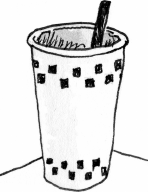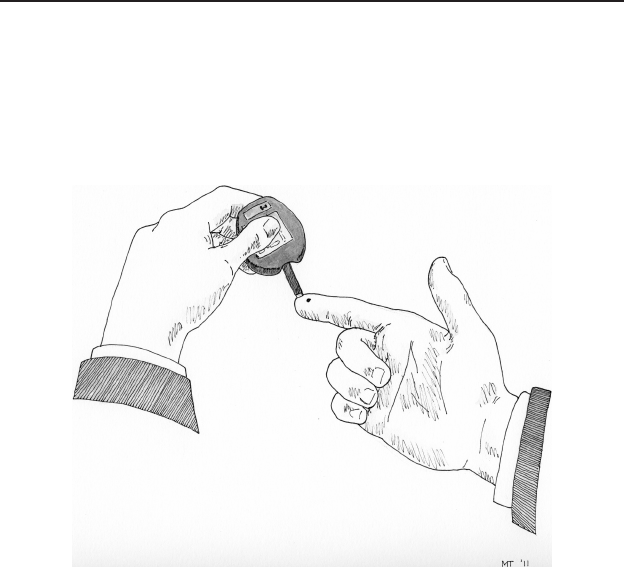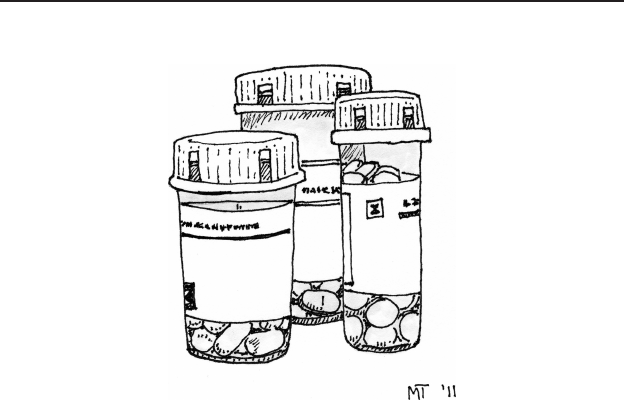
107
Chapter 10
Using Process
Behavior Charts
TRACY SCOTT MANAGES
HIS BLOOD SUGAR
As you eat and drink, glucose enters your
bloodstream. Then your pancreas secretes
a hormone that allows your body’s cells
to convert the glucose to energy—unless
your pancreas doesn’t. If that hormone
doesn’t materialize, the glucose will just
sit there, and then you’ll be in trouble.
Tracy Scott’s pancreas didn’t secrete that
hormone. So several times a day, he had to
determine his glucose level and whether
he needed to inject the hormone—
insulin—directly into his bloodstream
with a needle. Such is the life of a person
with type I diabetes. And food wasn’t the
only thing to consider: exercise, stress,
health, environmental factors, and other
While enjoying lunch with his friend
Daniel, Tracy, a diabetic, describes
his plan to control his blood sugar
levels. He distinguishes between
routine variability and special, or
assignable, causes (i.e., travel), which
might require him to eat unfamil-
iar or nonoptimal foods. His close,
systematic observation of the factors
that might increase his blood sugar
swings and his efforts to eliminate
them have had the effect of estab-
lishing a continuous process for
improving his self- care.
As you read Tracy’s story, think
about what he might do next on
his path of continually improving
his health.

108 THE LEAN ANTHOLOGY
medications could all affect glucose level. When it was high, Tracy
added insulin, but when it was low, all he could do was ingest some
carbohydrates as soon as possible, much as a blood donor is quickly
offered juice and crackers.
By planning his intake of carbohydrates at each meal, measuring his
blood glucose level several times a day, and adjusting his insulin level
by injection as needed, Tracy could avoid cardiovascular disease, kidney
failure, nerve damage, blindness, and amputation, among other health
risks. But keeping track of all this could be quite a complex process. Tracy
had made a game of it—something he not only had to do but also was
interested in doing. He used a spreadsheet to keep track of everything,
for example, which gave him another excuse to carry around his tablet.
While out to lunch with a colleague, Daniel Stagnaro, Tracy recorded
the hamburger and fries he ordered, piquing Daniel’s curiosity.

USING PROCESS BEHAVIOR CHARTS 109
Daniel: What are you doing?
Tracy: I have diabetes. I use this spreadsheet to keep track of things
that affect my blood sugar.
Daniel: Are you supposed to eat hamburgers?
Tracy: It’s hard to know what to eat sometimes. There are so many
factors that can affect your blood sugar when your body can’t
regulate it for you. Hamburgers are actually fine for my blood
sugar; it’s the fries I need to worry about.
Daniel: Really? Hamburgers?
Tracy: Hamburgers aren’t the greatest in terms of fat content, but from
a carb perspective, they’re okay.
Daniel: I have to take cholesterol- lowering medication. I know the feel-
ing. I don’t like the idea that I need to take medication to stay
healthy. Especially when the medication has other side effects.

110 THE LEAN ANTHOLOGY
Tracy: I have to take statins, too. On that front, the hamburger
might not have been such a good idea. As a matter of fact,
I take four medications related to the diabetes and choles-
terol problem.
Daniel: I feel your pain.
Tracy: Well, we all get dealt a different hand of cards, right? I’ve got
great children, an amazing wife, I love my job—not many
people can say all that. Diabetes management is a pain, but
it can be done. I use this spreadsheet to make a game of it.
Daniel: A game? How do you win?
Tracy: Every time I improve my process for managing the blood sugar
variations and lowering the average level.
Daniel: What do you mean?
Tracy: It’s just like any complex system with multiple, interacting
inputs and one resulting measured output. In this case, the
inputs to my spreadsheet are diet, exercise, medication, and
special causes. Special causes are usually something environ-
mental that’s either outside of my control or a change from
the normal routine. For instance, I usually bring my lunch.
Today is different because I ordered off a menu. The output
is my blood sugar, which I measure with this meter [takes it
out of his briefcase] and these test strips.
Daniel: Hmm, I’m still not seeing the “game” here. It’s great that you’ve got
a system down, but I don’t understand how you can improve.
Get The Lean Anthology now with the O’Reilly learning platform.
O’Reilly members experience books, live events, courses curated by job role, and more from O’Reilly and nearly 200 top publishers.

